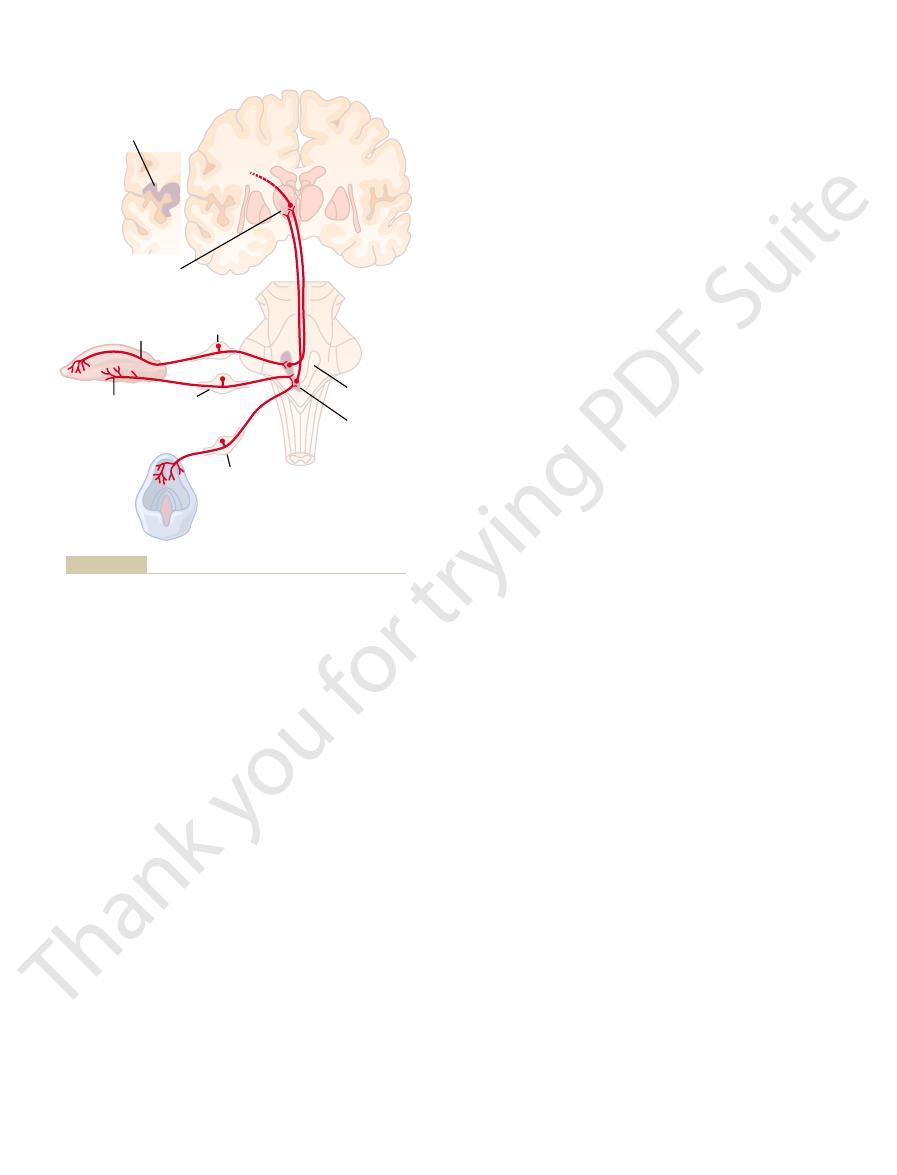
aldehydes, ketones, amides, esters, some amino acids, some small proteins,
of the types of chemicals that cause this taste include sugars, glycols, alcohols,
The sweet taste is not caused by any single class of chemicals. Some
Sweet Taste.
the salty taste, but the anions also contribute to a lesser extent.
The cations of the salts, especially sodium cations, are mainly responsible for
another, because some salts elicit other taste sensations in addition to saltiness.
concentration. The quality of the taste varies somewhat from one salt to
The salty taste is elicited by ionized salts, mainly by the sodium ion
Salty Taste.
the food, the stronger the sour sensation becomes.
That is, the more acidic
centration, and the intensity of this taste sensation is approximately propor-
The sour taste is caused by acids, that is, by the hydrogen ion con-
Sour Taste.
see are combinations of the three primary colors, as described in Chapter 50.
be combinations of the elementary taste sensations, just as all the colors we can
A person can perceive hundreds of different tastes. They are all supposed to
sour, salty, sweet, bitter,
They are
taste.
For practical analysis of taste, the aforementioned receptor capabilities have
1 glutamate receptor, and 1 hydrogen ion receptor.
1 adenosine receptor, 1 inosine receptor, 2 sweet receptors, 2 bitter receptors,
as follows: 2 sodium receptors, 2 potassium receptors, 1 chloride receptor,
identified at least 13 possible or probable chemical receptors in the taste cells,
not all known. Even so, psychophysiologic and neurophysiologic studies have
The identities of the specific chemicals that excite different taste receptors are
Primary Sensations of Taste
accord with the body tissues’ metabolic need for specific substances.
pepper, greatly alter the taste experience. The importance of taste lies in the
the presence of substances in the food that stimulate pain endings, such as
addition, the texture of food, as detected by tactual senses of the mouth, and
rience that one’s sense of smell also contributes strongly to taste perception. In
in the mouth, but it is common expe-
Taste is mainly a function of the
Sense of Taste
systems.
Finally, both senses are strongly tied to primitive
other animals or even individuals among animals.
pleasant to eat and nutritious. The sense of smell
The senses of taste and smell allow us to separate
Taste and Smell
The Chemical Senses—
C
H
A
P
T
E
R
5
3
663
undesirable or even lethal foods from those that are
also allows animals to recognize the proximity of
emotional and behavioral functions of our nervous
taste buds
fact that it allows a person to select food in accord with desires and often in
also been grouped into five general categories called the primary sensations of
and “umami.”
tional to the logarithm of the hydrogen ion concentration.

break up and dissolve. The life span of each taste cell
cells that lie toward the center of the bud; these soon
some taste cells are young cells. Others are mature
mitotic division of surrounding epithelial cells, so that
The taste cells are continually being replaced by
cells.
fied epithelial cells, some of which are supporting cells
limeter. The taste bud is composed of about 50 modi-
Figure 53–1 shows a taste bud, which has a diameter
Taste Bud and Its Function
tion of the substance.
people exhibit taste blindness; the exact percentage
carbamide,
compounds. A substance used frequently by psycholo-
substances, especially for different types of thiourea
Taste Blindness.
and sodium chloride, each of which is arbitrarily
sities of the taste of hydrochloric acid, quinine, sucrose,
sations of taste are referred, respectively, to the inten-
In this table, the intensities of four of the primary sen-
rocals of the taste thresholds) of different substances.
Table 53–1 gives the relative taste indices (the recip-
which would be expected, because this sensation pro-
sensitive is the bitter taste sense than all the others,
quinine, 0.000008 M. Note especially how much more
taste by sucrose, 0.01 M; and for the bitter taste by
the salty taste by sodium chloride, 0.01 M; for the sweet
hydrochloric acid averages 0.0009 N; for stimulation of
The threshold for stimulation of the sour taste by
Threshold for Taste
unclear.
synapses of the brain. However, the precise molecular
arate, fifth category of primary taste stimuli.
cheese, and some physiologists consider it to be a sep-
-glutamate, such as meat extracts and aging
bitter. Umami is the dominant taste of food contain-
is qualitatively different from sour, salty, sweet, or
is a Japanese word (meaning
Umami Taste.
these cause intensely bitter taste, usually followed by
poisonous plants are alkaloids, and virtually all of
taste sensation, because many deadly toxins found in
This is undoubtedly an important function of the bitter
The bitter taste, when it occurs in high intensity,
this substance objectionable to some people.
bitter aftertaste. This is true of saccharin, which makes
such as quinine, caffeine, strychnine, and nicotine.
alkaloids include many of the drugs used in medicines,
stances that contain nitrogen, and (2) alkaloids. The
bitter taste sensations: (1) long-chain organic sub-
almost entirely organic substances. Two particular
again, the substances that give the bitter taste are
caused by any single type of chemical agent. Here
The bitter taste, like the sweet taste, is not
Bitter Taste.
bitter.
radical, can often change the substance from sweet to
the chemical structure, such as addition of a simple
icals. It is especially interesting that slight changes in
lead and beryllium. Note specifically that most of the
sulfonic acids, halogenated acids, and inorganic salts of
The Nervous System: B. The Special Senses
664
Unit X
substances that cause a sweet taste are organic chem-
classes of substances are especially likely to cause
Some substances that at first taste sweet have a
usually causes the person or animal to reject the food.
rejection of the food.
Umami
“delicious”) designating a pleasant taste sensation that
ing
L
A taste receptor for
L
-glutamate may be related to
one of the glutamate receptors expressed in neuronal
mechanisms responsible for umami taste are still
vides an important protective function against many
dangerous toxins in food.
chosen to have a taste index of 1.
Some people are taste blind for certain
gists for demonstrating taste blindness is phenylthio-
for which about 15 to 30 per cent of all
depends on the method of testing and the concentra-
of about
1
/
30
millimeter and a length of about
1
/
16
mil-
called sustentacular cells and others of which are taste
Table 53–1
Carbonic acid
0.06
Morphine
0.02
Lactose
0.3
Citric acid
0.46
Cocaine
0.02
Galactose
0.32
Acetic acid
0.55
Atropine
0.13
Maltose
0.45
Potassium H tartrate
0.58
Pilocarpine
0.16
Glucose
0.8
KCl
0.6
Cl
2.5
Malic acid
0.6
Veratrine
0.2
Alanine
1.3
NH
Tartaric acid
0.7
Caffeine
0.4
Fructose
1.7
LiCl
0.4
Lactic acid
0.85
Phenylthiourea
0.9
Chloroform
40
NaI
0.35
Acetylacetic acid
0.85
Nicotine
1.3
Saccharin
675
NaBr
0.4
Chloracetic acid
0.9
Strychnine
3.1
4-nitrobenzene
CaCl
Formic acid
1.1
Brucine
11
1-Propoxy-2-amino-
5000
NaF
2
Hydrochloric acid
1
Quinine
1
Sucrose
1
NaCl
1
Sour Substances
Index
Bitter Substances
Index
Sweet Substances
Index
Salty Substances
Index
Relative Taste Indices of Different Substances
2
1
4
From Pfaffman C: Handbook of Physiology. Sec I, Vol 1. Baltimore: Williams & Wilkins, 1959, p. 507.

in the brain stem. Taste sensations
facial nerve,
chorda tympani
lingual nerve,
geal region into the central nervous system. Taste
Figure 53–2 shows the neuronal pathways for trans-
Transmission of Taste Signals into the
stimulus.
nerve, and a weaker continuous signal is transmitted
level as long as the taste stimulus remains. Thus, a
within the next few seconds back to a lower, steady
first application of the taste stimulus, the rate of dis-
Generation of Nerve Impulses by the Taste Bud.
cellular chemical changes that elicit the taste signals.
taste cells, and these second messengers cause intra-
tors. However, for the sweet and bitter taste sensations,
branes of the taste cells, thereby activating the recep-
and sour taste sensations, respectively, the receptor
For sodium ions and hydrogen ions, which elicit salty
The type of receptor protein in each taste villus
saliva, which removes the stimulus.
negativity of the cell. Then the taste chemical itself is
channels, which allows positively charged sodium ions
through a villus membrane. This, in turn, opens ion
The mechanism by which most stimulating sub-
for taste.
change in
centration of the stimulating substance. This
the decrease in potential, within a wide range, is
In most instances,
depolarized.
causes partial loss of this negative potential—that is,
tively charged on the inside with respect to the outside.
like that of most other sensory receptor cells, is nega-
The membrane of the taste cell,
Mechanism of Stimulation of Taste Buds
not fit into the “primary” categories.
stimuli, as well as by a few other taste stimuli that do
But at high concentration, most buds
primary taste stimuli when the taste substance is in low
Specificity of Taste Buds for a Primary Taste Stimulus.
become progressively less critical in old age.
taste buds degenerate, causing the taste sensation to
have a few more. Beyond the age of 45 years, many
Adults have 3000 to 10,000 taste buds, and children
the epiglottis, and even in the proximal esophagus.
palate, and a few are found on the tonsillar pillars, on
the tongue. Additional taste buds are located on the
tongue. (3) Moderate numbers are on the foliate papil-
tongue. (2) Moderate numbers of taste buds are on the
which form a V line on the surface of the posterior
the troughs that surround the circumvallate papillae,
three types of papillae of the tongue, as follows: (1)
The taste buds are found on
Location of the Taste Buds.
near the fibers. It is believed that these vesicles contain
branes. Many vesicles form beneath the cell membrane
are stimulated by the taste receptor cells. Some of
receptor surface for taste.
cavity of the mouth. These microvilli provide the
taste hairs,
microvilli,
of each taste cell, several
shown in Figure 53–1. From the tip
taste pore,
The outer tips of the taste cells are arranged around
humans.
The Chemical Senses—Taste and Smell
Chapter 53
665
is about 10 days in lower mammals but is unknown for
a minute
or
pro-
trude outward into the taste pore to approach the
Interwoven around the bodies of the taste cells is a
branching terminal network of taste nerve fibers that
these fibers invaginate into folds of the taste cell mem-
a neurotransmitter substance that is released through
the cell membrane to excite the nerve fiber endings in
response to taste stimulation.
A large number of taste buds are on the walls of
fungiform papillae over the flat anterior surface of the
lae located in the folds along the lateral surfaces of
Micro-
electrode studies from single taste buds show that each
taste bud usually responds mostly to one of the five
concentration.
can be excited by two or more of the primary taste
Receptor Potential.
Application of a taste substance to the taste hairs
the taste cell becomes
approximately proportional to the logarithm of con-
electrical potential in the taste cell is called the recep-
tor potential
stances react with the taste villi to initiate the recep-
tor potential is by binding of the taste chemical to a
protein receptor molecule that lies on the outer
surface of the taste receptor cell near to or protruding
or hydrogen ions to enter and depolarize the normal
gradually washed away from the taste villus by the
determines the type of taste that will be perceived.
proteins open specific ion channels in the apical mem-
the portions of the receptor protein molecules that
protrude through the apical membranes activate
second-messenger transmitter substances inside the
On
charge of the nerve fibers from taste buds rises to a
peak in a small fraction of a second but then adapts
strong immediate signal is transmitted by the taste
as long as the taste bud is exposed to the taste
Central Nervous System
mission of taste signals from the tongue and pharyn-
impulses from the anterior two thirds of the tongue
pass first into the
then through the
into the
and finally into
the tractus solitarius
from the circumvallate papillae on the back of the
Stratified
squamous
epithelium
Pore
Microvilli
Nerve fibers
Taste cells
Subepithelial
connective
tissue
Taste bud.
Figure 53–1

lower animals.
thereafter; the same effect can be demonstrated in
preference, or
of food, the person generally develops a negative taste
determining one’s taste preferences. For instance, if a
needed nutrient. An important reason for believing
the taste receptors themselves, although it is true that
The phenomenon of taste preference almost cer-
our bodies from undesirable substances.
affective sensation, which in many instances protects
known to attract animals from far and wide. Also,
life. For instance, the “salt licks” of desert regions are
The same phenomena are also observed in everyday
calcium chloride.
food from among many samples. Third, calcium-
amounts of insulin develops a depleted blood sugar,
Second, an animal given injections of excessive
pure water, and this is often sufficient to supply the
of their bodies. First, adrenalectomized,
The following experiments demonstrate this ability
certain specific substances.
ences often change in accord with the body’s need for
the type of diet it eats. Furthermore, its taste prefer-
choose certain types of food in preference to others,
Taste preference
Taste Preference and Control
the receptors.
other sensory systems, which adapt almost entirely at
rate, it is a mechanism different from that of most
the mechanism and site of this are not known. At any
occurs in the central nervous system itself, although
this. Therefore, the final extreme degree of adaptation
fibers, it is clear that adaptation of the taste buds them-
tion. Yet, from electrophysiologic studies of taste nerve
that taste sensations adapt rapidly, often almost com-
Adaptation of Taste.
signals to the submandibular, sublingual, and parotid
tractus solitarius, many taste signals are transmitted
From the
Taste Reflexes Integrated in the Brain Stem.
pathways from the tongue.
I. From this description of the taste pathways, it is
This lies slightly lateral, ventral, and rostral to the
, and into the adjacent
lower tip of the postcentral gyrus in
system. From the thalamus, third-order neurons are
posterior medial nucleus of the thalamus,
These nuclei send
nuclei of the tractus solitarius.
vagus nerve.
slightly more posterior level. Finally, a few taste signals
tractus solitarius,
The Nervous System: B. The Special Senses
666
Unit X
tongue and from other posterior regions of the mouth
and throat are transmitted through the glossopharyn-
geal nerve also into the
but at a
are transmitted into the tractus solitarius from the base
of the tongue and other parts of the pharyngeal region
by way of the
All taste fibers synapse in the posterior brain stem
in the
second-order neurons to a small area of the ventral
located
slightly medial to the thalamic terminations of the
facial regions of the dorsal column–medial lemniscal
transmitted to the
the parietal cerebral cortex, where it curls deep into the
sylvian fissure
opercular insular
area.
area for tongue tactile signals in cerebral somatic area
evident that they closely parallel the somatosensory
within the brain stem itself directly into the superior
and inferior salivatory nuclei, and these areas transmit
glands to help control the secretion of saliva during the
ingestion and digestion of food.
Everyone is familiar with the fact
pletely within a minute or so of continuous stimula-
selves usually accounts for no more than about half of
that occurs in the sensation of taste almost certainly
of the Diet
simply means that an animal will
and the animal automatically uses this to help control
of animals to choose food in accord with the needs
salt-depleted
animals automatically select drinking water with a
high concentration of sodium chloride in preference to
needs of the body and prevent salt-depletion death.
and the animal automatically chooses the sweetest
depleted parathyroidectomized animals automatically
choose drinking water with a high concentration of
human beings reject any food that has an unpleasant
tainly results from some mechanism located in the
central nervous system and not from a mechanism in
the receptors often become sensitized in favor of a
that taste preference is mainly a central nervous
system phenomenon is that previous experience with
unpleasant or pleasant tastes plays a major role in
person becomes sick soon after eating a particular type
taste aversion, for that particular food
Nucleus of
solitary tract
Gustatory
area
Gustatory cortex
(anterior insula-
frontal operculum)
Ventral posterior
medial nucleus of
thalamus
Geniculate
ganglion
N. VII
N. IX
N. X
Petrosal
ganglion
Nodose
ganglion
Pharynx
Glossopharyngeal
Tongue
Chorda
tympani
Transmission of taste signals into the central nervous system.
Figure 53–2

non-lipid-soluble odorants.
slightly lipid soluble, presumably because lipid con-
Third, it is helpful for the substance to be at least
can be smelled. Second, the stimulating substance
ical factors affect the degree of stimulation. First, only
which the olfactory cells are stimulated, several phys-
channels. This accounts for the exquisite sensitivity of
ion channels. Therefore, even the most minute con-
Finally, the cAMP opens still many times more sodium
formation of many times more molecules of cAMP. (4)
inside the olfactory cell membrane. (3) This causes the
turn, activates multiple molecules of adenylyl cyclase
substance activates the G-protein complex. (2) This, in
(1) Activation of the receptor protein by the odorant
tory effect of even the weakest odorant.To summarize:
The importance of this mechanism for activating
olfactory nerve.
itive direction inside the cell membrane, thus exciting
the membrane into the receptor cell cytoplasm. The
that opens its “gate” and
gated sodium ion channel,
cAMP activates another nearby membrane protein, a
(cAMP). Finally, this
cell body. The activated cyclase, in turn, converts many
adenylyl cyclase,
units. On excitation of the receptor protein, an
of the folding protein, however, is coupled to a so-
receptor protein that folds to the outside. The inside
outward. The odorant binds with the portion of the
the membrane about seven times, folding inward and
membrane of each cilium. Each receptor protein is
the cilia. Then it binds with
brane surface, first diffuses into the mucus that covers
stance, on coming in contact with the olfactory mem-
. The odorant sub-
The portion
Mechanism of Excitation of the Olfactory Cells.
Stimulation of the Olfactory Cells
membrane.
Bowman
later. Spaced among the olfactory cells in the olfactory
the air and stimulate the olfactory cells, as discussed
the mucus, and it is these cilia that react to odors in
These projecting olfactory cilia form a dense mat in
mucus that coats the inner surface of the nasal cavity.
and up to 200 micrometers in length, project into the
), measuring 0.3 micrometer in diameter
53–3. The mucosal end of the olfactory cell forms a
as shown in Figure
sustentacular cells,
central nervous system itself. There are about 100
(see Figure 53–3), which are
The receptor cells for the smell sensa-
Olfactory Cells.
a surface area of about 2.4 square centimeters.
turbinate. In each nostril, the olfactory membrane has
ally, it folds over the superior turbinate and even over
ward along the surface of the superior septum; later-
nostril. Medially, the olfactory membrane folds down-
shown in Figure 53–3, lies in the superior part of each
The olfactory membrane, the histology of which is
lower animals.
in lower animals. Another complicating problem is
Smell is the least understood of our senses. This results
The Chemical Senses—Taste and Smell
Chapter 53
667
Sense of Smell
partly from the fact that the sense of smell is a sub-
jective phenomenon that cannot be studied with ease
that the sense of smell is poorly developed in human
beings in comparison with the sense of smell in many
Olfactory Membrane
a small portion of the upper surface of the middle
tion are the olfactory cells
actually bipolar nerve cells derived originally from the
million of these cells in the olfactory epithelium inter-
spersed among
knob from which 4 to 25 olfactory hairs (also called
olfactory cilia
membrane are many small
’s glands that
secrete mucus onto the surface of the olfactory
of each olfactory cell that responds to the olfactory
chemical stimuli is the olfactory cilia
receptor proteins in the
actually a long molecule that threads its way through
called G-protein, itself a combination of three sub-
alpha
subunit breaks away from the G-protein and immedi-
ately activates
which is attached to
the inside of the ciliary membrane near the receptor
molecules of intracellular adenosine triphosphate into
cyclic adenosine monophosphate
allows large numbers of sodium ions to pour through
sodium ions increase the electrical potential in the pos-
the olfactory neuron and transmitting action poten-
tials into the central nervous system by way of the
olfactory nerves is that it greatly multiplies the excita-
centration of a specific odorant initiates a cascading
effect that opens extremely large numbers of sodium
the olfactory neurons to even the slightest amount of
odorant.
In addition to the basic chemical mechanism by
volatile substances that can be sniffed into the nostrils
must be at least slightly water soluble so that it can
pass through the mucus to reach the olfactory cilia.
stituents of the cilium itself are a weak barrier to
Bowman’s
gland
Sustentacular
cells
Olfactory cell
Olfactory cilia
Mucus layer
Olfactory tract
Olfactory bulb
Glomerulus
Mitral cell
connections to the olfactory tract.
Organization of the olfactory membrane and olfactory bulb, and
Figure 53–3

emotions and other aspects of human behavior; this is
around these olfactory beginnings. In fact, part of
first brain structures developed in primitive animals,
The olfactory portions of the brain were among the
Transmission of Smell Signals into
intensities.
1 trillion to 1 in the case of the ears. This difference
for example, 500,000 to 1 in the case of the eyes and
to most other sensory systems of the body, in which the
evoke maximum intensity of smell. This is in contrast
extremely slight, for many (if not most) odorants, con-
of gas leak from a pipeline.
liliter of air. Because of this very low threshold, this
the air that can elicit a smell sensation. For instance,
drive.
lower animals, odors are the primary excitant of sexual
havoc with human emotions. In addition, in some
Conversely, perfume of the right quality can wreak
Indeed, a person who has previously eaten food that
Because of this, smell is probably even
unpleasantness.
taste, has the affective quality of either
Smell, even more so than
olfactory cells for that particular substance.
been identified for more than 50 different substances.
for single substances; such discrete odor blindness has
sensations of taste detected by the tongue. Further
encode for the receptor proteins, suggest the existence
clues, including specific studies of the genes that
primary sensations of smell. In recent years, multiple
7. Putrid
6. Pungent
5. Ethereal
4. Pepperminty
3. Floral
2. Musky
1. Camphoraceous
sensations. Based on psychological studies, one at-
discrete primary sensations, in the same way that
In the past, most physiologists were convinced that the
Search for the Primary Sensations of Smell
bulb.
of an olfactory stimulus, the central nervous system
granule cells.
on special inhibitory cells in the olfactory bulb, the
tion is the following: Large numbers of centrifugal
within the central nervous system. This seems to be
of adaptation of the receptors themselves, it is almost
entering a strongly odorous atmosphere. Because this
after, they adapt very little and very slowly. Yet we all
cent in the first second or so after stimulation. There-
The olfactory receptors adapt about 50 per
receptors.
logarithm of the stimulus strength, which demon-
Over a wide range, the rate of olfactory nerve
fibers.
positive direction. Along with this, the number of
millivolts or less—that is, changing the voltage in the
cell membrane, decreasing the negative potential in
erate continuous action potentials at a very slow rate,
–55 millivolts. At this potential, most of the cells gen-
cells, as measured by microelectrodes, averages about
The membrane potential inside unstimulated olfactory
Membrane Potentials and Action Potentials in Olfactory Cells.
The Nervous System: B. The Special Senses
668
Unit X
varying from once every 20 seconds up to two or three
per second.
Most odorants cause depolarization of the olfactory
the cell from the normal level of –55 millivolts to –30
action potentials increases to 20 to 30 per second,
which is a high rate for the minute olfactory nerve
impulses changes approximately in proportion to the
strates that the olfactory receptors obey principles
of transduction similar to those of other sensory
Adaptation.
know from our own experience that smell sensations
adapt almost to extinction within a minute or so after
psychological adaptation is far greater than the degree
certain that most of the additional adaptation occurs
true for the adaptation of taste sensations as well.
A postulated neuronal mechanism for the adapta-
nerve fibers pass from the olfactory regions of the
brain backward along the olfactory tract and terminate
It has been postulated that after the onset
quickly develops strong feedback inhibition to sup-
press relay of the smell signals through the olfactory
many smell sensations are subserved by a few rather
vision and taste are subserved by a few select primary
tempt to classify these sensations is the following:
It is certain that this list does not represent the true
of at least 100 primary sensations of smell—a marked
contrast to only three primary sensations of color
detected by the eyes and only four or five primary
support for the many primary sensations of smell is
that people have been found who have odor blindness
It is presumed that odor blindness for each substance
represents lack of the appropriate receptor protein in
“Affective Nature of Smell.”
pleasantness or
more important than taste for the selection of food.
disagreed with him or her is often nauseated by the
smell of that same food on a second occasion.
Threshold for Smell.
One of the principal characteristics
of smell is the minute quantity of stimulating agent in
the substance methylmercaptan can be smelled when
only one 25 trillionth of a gram is present in each mil-
substance is mixed with natural gas to give the gas an
odor that can be detected when even small amounts
Gradations of Smell Intensities.
Although the threshold
concentrations of substances that evoke smell are
centrations only 10 to 50 times above the threshold
ranges of intensity discrimination are tremendous—
might be explained by the fact that smell is concerned
more with detecting the presence or absence of
odors rather than with quantitative detection of their
the Central Nervous System
and much of the remainder of the brain developed
the brain that originally subserved olfaction later
evolved into the basal brain structures that control
the system we call the limbic system, discussed in
Chapter 58.

ably helps in the conscious analysis of odor.
Based on studies in monkeys, this newer system prob-
been found that passes through the thalamus, passing
The Newer Pathway.
without passing first through the thalamus.
. This is the only area of the entire cerebral
vomiting.
instance, it is believed that this lateral olfactory
depending on one’s experiences with them. For
such as the hippocampus, which seem to be most
limbic system, especially into less primitive portions
From these areas,
pyriform cortex
prepyriform
The lateral olfactory area is composed mainly of the
The Less Old Olfactory System—The Lateral Olfactory Area.
conditioned reflexes.
associated with smell. Conversely, removal of the
lips, salivation, and other feeding responses caused by
primitive responses to olfaction, such as licking the
remains. The answer is that this hardly affects the more
The importance of this medial olfactory area is best
of the brain’s limbic system. This is the brain area
ately anterior to the hypothalamus. Most conspicuous
The medial olfactory area consists of a group of nuclei
The Very Old Olfactory System—The Medial Olfactory Area.
The medial
of the brain stem, and the other passing
Figure 53–4, one passing medially into the
there, the tract divides into two pathways, as shown in
The olfactory tract enters the brain at the anterior
Central Nervous System
Newer Olfactory Pathways into the
The Very Old, the Less Old, and the
glomeruli respond to different odors. It is possible that
olfactory cell neurons, and the mitral and tufted cells
glomeruli. These dendrites receive synapses from the
tufted cells,
from olfactory cells. Each glomerulus also is the ter-
and the olfactory bulb, showing short axons from
cavity. Figure 53–3 demonstrates the close relation
The cribriform plate has multiple small perforations
cavity from the upper reaches of the nasal cavity.
cribriform plate,
olfactory bulb,
the bulbous enlargement at its end, the
in reality, both the tract and the bulb are an anterior
. However,
, or the
is shown in Figure 53–4. The olfactory
The
Transmission of Olfactory Signals into the Olfactory Bulb.
The Chemical Senses—Taste and Smell
Chapter 53
669
olfactory bulb
nerve fibers leading backward from the bulb are called
cranial nerve I
olfactory tract
outgrowth of brain tissue from the base of the brain;
lies over the
separating the brain
through which an equal number of small nerves
pass upward from the olfactory membrane in the
nasal cavity to enter the olfactory bulb in the cranial
between the olfactory cells in the olfactory membrane
the olfactory cells terminating in multiple globular
structures within the olfactory bulb called glomeruli.
Each bulb has several thousand such glomeruli,
each of which is the terminus for about 25,000 axons
minus for dendrites from about 25 large mitral cells
and about 60 smaller
the cell bodies of
which lie in the olfactory bulb superior to the
send axons through the olfactory tract to transmit
olfactory signals to higher levels in the central nervous
system.
Some research has suggested that different
specific glomeruli are the real clue to the analysis of
different odor signals transmitted into the central
nervous system.
junction between the mesencephalon and cerebrum;
medial
olfactory area
laterally into the lateral olfactory area.
olfactory area represents a very old olfactory system,
whereas the lateral olfactory area is the input to (1) a
less old olfactory system and (2) a newer system.
located in the midbasal portions of the brain immedi-
are the septal nuclei, which are midline nuclei that feed
into the hypothalamus and other primitive portions
most concerned with basic behavior (described in
Chapter 58).
understood by considering what happens in animals
when the lateral olfactory areas on both sides of the
brain are removed and only the medial system
the smell of food or by primitive emotional drives
lateral areas abolishes the more complicated olfactory
and
plus the cortical
portion of the amygdaloid nuclei.
signal pathways pass into almost all portions of the
important for learning to like or dislike certain foods
area and its many connections with the limbic behav-
ioral system cause a person to develop an absolute
aversion to foods that have caused nausea and
An important feature of the lateral olfactory area is
that many signal pathways from this area also feed
directly into an older part of the cerebral cortex called
the paleocortex in the anteromedial portion of the tem-
poral lobe
cortex where sensory signals pass directly to the cortex
A newer olfactory pathway has now
to the dorsomedial thalamic nucleus and then to the
lateroposterior quadrant of the orbitofrontale cortex.
Olfactory
nerve
Olfactory
bulb
Olfactory
tract
Mitral
cell
Temporal
cortex
Orbito-
frontal
cortex
Hypothalamus
Brain stem
Prefrontal
cortex
Medial olfactory area
Lateral
olfactory
area
Hippocampus
Neural connections of the olfactory system.
Figure 53–4

284:32, 2001.
Smith DV, Margolskee RF: Making sense of taste. Sci Am
hedonic aspects of taste. Brain Res Bull 62:271, 2004.
Sewards TV: Dual separate pathways for sensory and
duction. Annu Rev Physiol 64:189, 2002.
Ronnett GV, Moon C: G proteins and olfactory signal trans-
13:482, 2003.
tory organization and development. Curr Opin Neurobiol
Reed RR: The contribution of signaling pathways to olfac-
sweet taste. Curr Opin Neurobiol 12:366, 2002.
Montmayeur JP, Matsunami H: Receptors for bitter and
revisited. Curr Opin Neurobiol 14:31, 2004.
sensory neurons: the one receptor–one neuron hypothesis
Mombaerts P: Odorant receptor gene choice in olfactory
and taste receptors. Nat Rev Neurosci 5:263, 2004.
Mombaerts P: Genes and ligands for odorant, vomeronasal
Sci 19:101, 2004.
odorant molecules to the olfactory cortex. News Physiol
Menini A, Lagostena L, Boccaccio A: Olfaction: from
robiol 13:469, 2003.
of olfactory transduction and adaptation. Curr Opin Neu-
Matthews HR, Reisert J: Calcium, the two-faced messenger
taste transduction. J Biol Chem 277:1, 2002.
Margolskee RF: Molecular mechanisms of bitter and sweet
Neurobiol 13:476, 2003.
Lowe G: Electrical signaling in the olfactory bulb. Curr Opin
brain. Neuroreport 14:1655, 2003.
Lledo PM, Gheusi G: Olfactory processing in a changing
robiology of preference. J Nutr 133:831S, 2003.
Levine AS, Kotz CM, Gosnell BA: Sugars and fats: the neu-
transduction. Annu Rev Physiol 61:873, 1999.
Herness MS, Gilbertson TA: Cellular mechanisms of taste
putative odorant receptors. Annu Rev Neurosci 23:417,
Gibson AD, Garbers DL: Guanylyl cyclases as a family of
Rev Physiol 64:129, 2002.
Dohlman HG: G proteins and pheromone signaling. Annu
nition memory. Nat Rev Neurosci 5:209, 2004.
Bermudez-Rattoni F: Molecular mechanisms of taste-recog-
guish one odor from another.
means for sharpening one’s specific ability to distin-
send inhibitory signals to the mitral and tufted cells. It
and tufted cells in the olfactory bulb. The granule cells
brain to the periphery). These terminate on a large
to the olfactory bulb (i.e., “centrifugally” from the
Central Nervous System.
Centrifugal Control of Activity in the Olfactory Bulb by the
and unhealthy foods, and a
system that subserves the basic olfactory reflexes, a
Thus, there appear to be a
Summary.
The Nervous System: B. The Special Senses
670
Unit X
very old olfactory
less old system that provides automatic but partially
learned control of food intake and aversion to toxic
newer system that is com-
parable to most of the other cortical sensory systems
and is used for conscious perception and analysis of
olfaction.
Many nerve fibers that originate
in the olfactory portions of the brain pass from the
brain in the outward direction into the olfactory tract
number of small granule cells located among the mitral
is believed that this inhibitory feedback might be a
References
2000.
